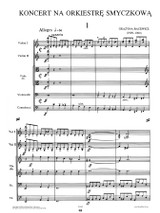REPRINT SERIES
The Concerto for String Orchestra (1948) is commonly regarded as Grażyna Bacewicz's opus magnum and even called her "Ninth Symphony". It is unquestionably one of the foremost works of 20th century Polish music.
Written in 1948, the Concerto was first performed by the Polish Radio Symphony Orchestra under Grzegorz Fitelberg on 18th June 1950, marking the General Meeting of the Polish Composers' Union. Stefan Kisielewski, himself a Union member, noted down:
"One can say with a clear conscience that this time the dignity of the Polish composers was saved by a woman, Grażyna Bacewicz. Her 'Concerto for String Orchestra', written with gusto and energy, brimming with fluent inventiveness and excellent instrumentation ideas, has finally woken us up from lethargy. The work makes references to some Bach or Haendel: a contemporary Brandenburg Concerto. Here we have at last tasted a 'red-blooded piece' of healthy and tasty music written with male-like creative power".
The Concerto earned Bacewicz the State Award of the 3rd degree later that year, and in 1952 it impressed the US audience at a concert played by the National Symphony Orchestra. In 1956 it was performed by the Orchestre National de la Radiodiffusion et Télévision Française under Jean Martinon at the 1st Warsaw Autumn International Festival of Contemporary Music and would feature at the festival editions three more times, a score that few works of music have matched in the event's forty-five-year history.
Considered "one of the finest examples of neoclassicism in Polish music", the Concerto for String Orchestra is surely an excellent demonstration of Bacewicz's striving for the most harmonious combination of tradition and modernity. Of course, the term 'neoclassicism' is used in the broad understanding of the word, the Concerto making references to classical and well as Baroque music. Take Allegro, the first movement: its form is classical - or rather early classical - but its main theme clearly utilizes Baroque melorythmics. Likewise, the lyrical second movement, Andante, features a number of solo fragments played by various instruments producing a varied and diverse sound colours reminiscent of Baroque. Finally Vivo, the third movement, introduces the elements of the rondo and sonata forms, applying them to a bouncy, folksy music. It seems only appropriate to call the Concerto a synergy of a neoclassical form and neo-Baroque content.
- Difficulty:
- Intermediate/Advanced
- Instrumentation:
- String Orchestra
- Duration:
- 15 minutes
- Set of Parts:
- Includes Strings count 5.5.4.4.3
- Product Type:
- REPRINT SERIES







